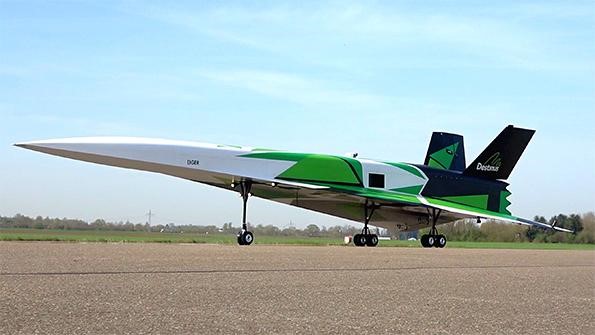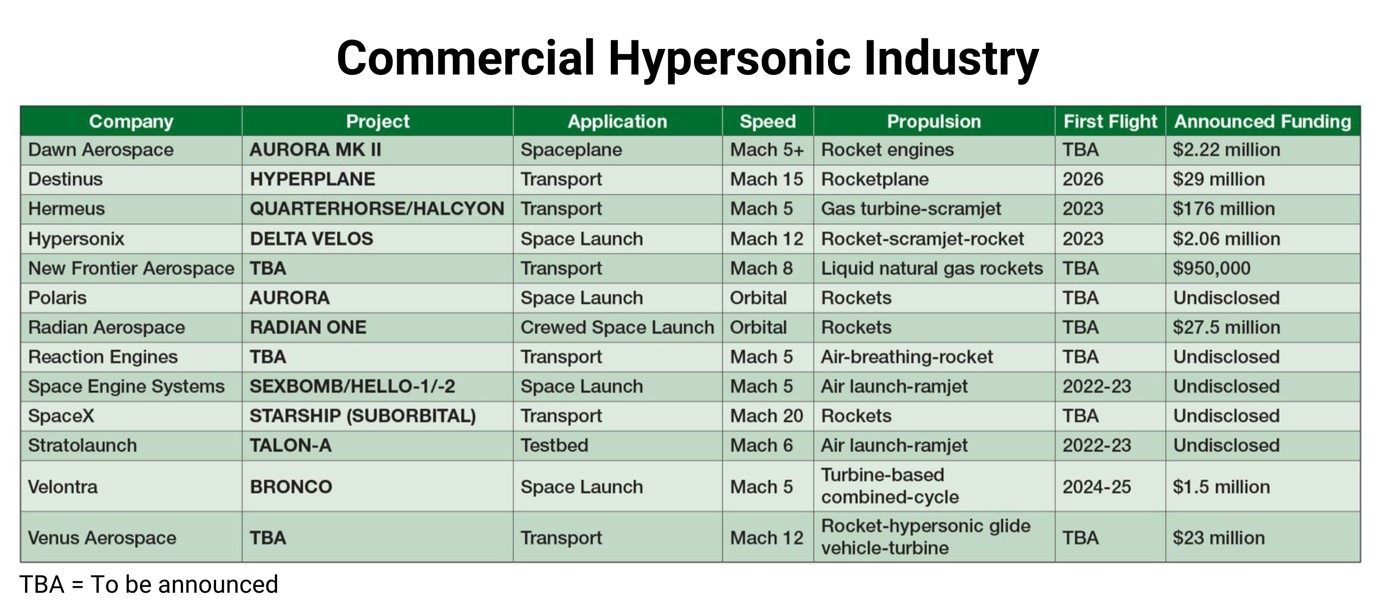
Programmes
AeroForum
Home >
Top Reads >
Investors buy into commercial hypersonic plans
Investors buy into commercial hypersonic plans
Investors buy into commercial hypersonic plans
INDUSTRY 360° | 23 JUNE 2022
 |
|---|
Hypersonix
Since the first flight faster than Mach 5 of a U.S. Army rocket in 1949, hypersonic flight has been the exclusive domain of military weapons programs and science projects by civilian government agencies. But the government monopoly on hypersonic speed could be broken later this year.
At least 13 startups and established commercial companies have announced plans to demonstrate hypersonic vehicles, with several having test flights scheduled within the next three years.
These profit-seeking projects face the same technical challenges that have foiled or complicated all but a handful of government-sponsored hypersonic weapons. Yet the commercial firms continue to attract major investment by venture capitalists and government agencies.
In April, Venus Aerospace, a two-year-old Houston-based startup seeking to build a hypersonic airliner, closed a $20 million Series A funding round by Prime Movers Lab, a venture fund for startups hoping to create businesses from scientific breakthroughs. The Series A round added to a $3 million seed investment in Venus Aerospace that closed in March 2021.
Two months earlier, a consortium of venture funds invested $29 million in Destinus SA, a Switzerland-based startup founded by a Russian entrepreneur, that is developing a hydrogen-powered, hypersonic freighter.
Washington-based Radian Aerospace exited stealth mode a month before Destinus, raising $27.5 million in a seed round to develop a single-stage-to-orbit spaceplane, with letters of intent worth $1.5 billion for a range of potential services, including satellite launches, space station resupply and point-to-point transport.
The wave of new startups follows long-term efforts by Stratolaunch, SpaceX and Reaction Engines to field airborne satellite launchers, orbital transport ships and spaceplanes.
In terms of attracting investment, Atlanta-based startup Hermeus has been the most successful. The company’s plan to develop a series of hypersonic vehicles—starting with the Quarterhorse demonstrator, which could be spun off into a revenue-generating testbed or operational system—has attracted $126 million in venture capital funding, including a stake by RTX Ventures and another investment by the U.S. Air Force worth up to $60 million.
In all, nine commercial companies have raised more than $424 million in funding and contracts for hypersonic projects, along with another four startups that have yet to announce fundraising results.
The projects cover many different types of applications, ranging from satellite launchers and space transports to experimental testbeds. Not surprisingly, the diversity of applications is supported by an eclectic mix of operational concepts and propulsion technologies.
History suggests the path to fielding a successful hypersonic vehicle is daunting. President Ronald Reagan’s “Orient Express” vision for a Mach 25 airliner ended in failure in 1990, with the cancellation of the Rockwell X-30 National Aero-Space Plane as budget estimates soared and technical concerns mounted. Subsequent efforts in the mid-1990s to field the McDonnell Douglas Delta Clipper and Lockheed Martin VentureStar fell victim to NASA budget cutting.
A more recent attempt to demonstrate the potential for commerce-oriented spaceplanes requiring a hypersonic reentry capability also failed, but not for any technical or cost reason. In 2017, DARPA picked Boeing over several bids by small companies for a $146 million contract to design and launch the XS-1, an experimental spaceplane that could release small satellites in orbit. But Boeing decided to walk away from the program in January 2020, a decision that came as the company was coping with the grounding of the 737 MAX and costly setbacks by other commercial and military programs unrelated to the XS-1.
Despite the series of government-funded failures, the commercial imperative for many types of hypersonic vehicles is clear.
For example, the SpaceX Falcon 9 rocket stimulated demand for access to Earth orbit by reducing launch costs to as low as $2,938 per kilogram to low Earth orbit, according to the company’s standard rate card for launches in 2022. Although proven to be reliably reusable and highly successful, the Falcon 9 rocket remains burdened by certain inefficiencies inherent to any rocket, such as requiring a propellant mixture composed of likely 70-80% liquid oxygen.
By switching to an air-breathing, hypersonic vehicle that is reusable, some of the new commercial startups hope to make a profit by dramatically lowering launch costs still further. Space Engine Systems, a Canadian startup, expects the ramjet-powered Hello-2 vehicle to launch small satellites to low Earth orbit for $950 per kilogram. Ohio-based Velontra, meanwhile, has a similar objective for the Bronco, a reusable satellite launch system powered by a turbine-based combined-cycle engine.

AWN
But the business model for commercial hypersonic flight remains challenging. Airbus and Boeing have sometimes struggled to make a profit on subsonic airliners. Air France and British Airways enjoyed profits from Concorde operation through most of its career, but the unexpected cost increases of developing the supersonic airliner would have driven the manufacturing team into bankruptcy without funding by the French and British governments. Attempting to deliver a profitable, hypersonic-speed, passenger transport, such as the Hermeus Halcyon, puts a lot pressure on the business case.
“I’m an engineer, so it’s a little bit hypocritical or heretical for me to say this. But, yes, [although] the technical challenges are hard, the business challenges and financial challenges are the real requirements here,” says Hermeus co-founder A.J. Piplica, who addressed a webinar hosted by the McKinsey consultancy on May 17.
Funding “is not just going to come from raising private capital,” Piplica adds. “You have to be bringing in revenue along the way. So what problems can you solve to do that?”
For Hermeus, the Quarterhorse demonstrator is being designed to validate the performance of the company’s Chimera turbine-based combined-cycle engine, but not only that. The Quarterhorse also could be used by the Air Force, which is in the process of selecting a company to produce a hypersonic testbed called Mayhem.
Financial pressures are felt beyond Hermeus. Venus Aerospace, the Houston-based startup, is proposing to build an airliner that can fly passengers at Mach 9 at 170,000 ft. across the Pacific Ocean. The Venus Aerospace concept includes three technologies that have never been commercialized: a rotating detonation engine, a waverider airframe and a new type of cooling system embedded into the leading edge. All three remain experimental even in the military sector, but those are engineering problems.
As the top executive at Venus, Sarah “Sassie” Duggleby says, her biggest concerns are financial. “I’ll be honest, the thing that keeps me up at night is funding, and I think that’s my role as the CEO. You know, making sure we never run out of money,” said Duggleby, another speaker at the McKinsey webinar.
Even SpaceX—now, a successful, 20-year-old rocket company—may rely on government funding to make the point-to-point transport variant of the Starship successful. The Starship is expected to be a candidate for the Rocket Cargo program, a high-priority effort by the Air Force Research Laboratory to demonstrate the ability to resupply any point on the planet within about 1 hr.
By: Steve Trimble
This article was first published in Aviation Week & Space Technology.
Stay current with Aviation Week Network’s latest news, analysis and insights impacting the global aviation community.
Sign up for one or more of their sector-specific digests.
